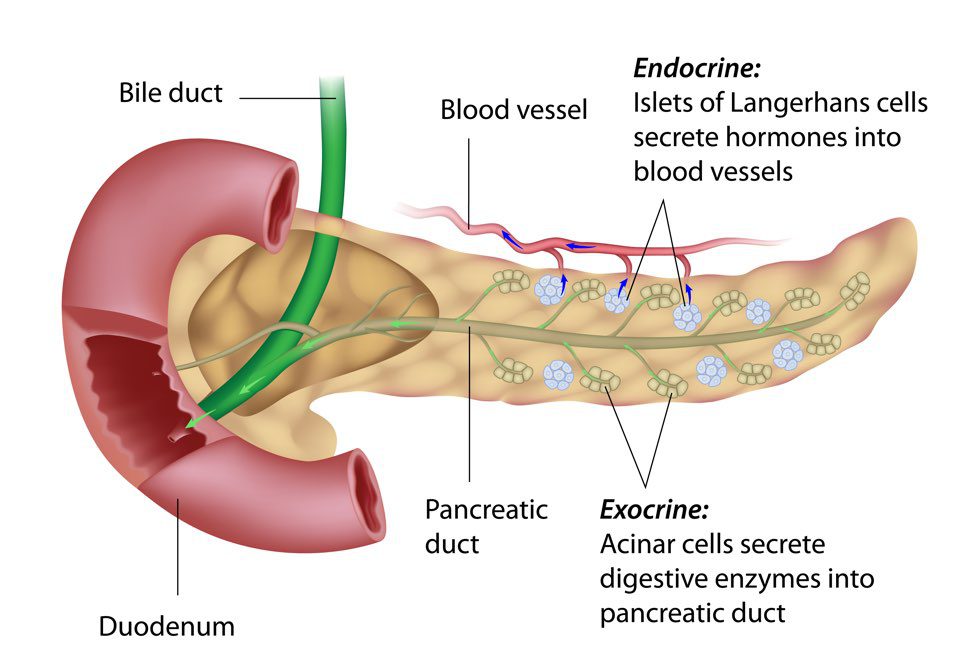The pancreas is a large gland located behind the stomach and is connected to the digestive tract via the main pancreatic duct. It plays a crucial role in converting the food we eat into fuel for the body’s cells and regulating our blood sugar levels.
–

–
Pancreatic Functions:
- Exocrine Function: The pancreas produces enzymes released into its ducts. These enzymes, mixed with digestive juices, help absorb nutrients by breaking down food in the duodenum.
- Endocrine Function: The pancreas produces hormones such as insulin and glucagon, released directly into the bloodstream. These hormones aid digestion and help regulate blood sugar levels.
Specialised areas within the pancreas, called islets of Langerhans, contain different types of cells that produce hormones. The most common are beta cells, which produce insulin, and alpha cells, which produce glucagon. Insulin controls how the body uses carbohydrates, while glucagon prevents blood sugar levels from dropping too low.
Diabetes Overview:
Diabetes typically involves problems with insulin production or function or both. While most people are familiar with Type 1 and Type 2 diabetes, there are less common types, including Type 3c diabetes.
–

–
Type 3c Diabetes:
Type 3c diabetes, also known as diabetes of the exocrine pancreas, secondary pancreatic diabetes, or pancreatogenic diabetes, results from pancreatic disease such as pancreatitis, cystic fibrosis, and pancreatic malignancies. It accounts for about 8% of all diabetes cases. Type 3c diabetes can be challenging to diagnose and manage due to erratic blood sugar levels caused by pancreatic tissue damage.
Symptoms of Type 3c diabetes may include glucose intolerance, abdominal pain, and symptoms of both pancreatic enzyme insufficiency and diabetes, such as:
- Pancreatic Enzyme Insufficiency Symptoms:
- Abdominal discomfort or pain
- Bloating and flatulence
- Steatorrhea (oily, smelly stools)
- Weight loss
- Malnutrition and vitamin deficiencies
- Nausea and colicky discomfort after eating
- Heartburn and indigestion
- Lethargy and fatigue
- Diabetes Symptoms:
- Increased thirst and urination
- Lethargy
- Weight loss or increased hunger
- Genital itching and frequent thrush
- Impaired healing of cuts or wounds
- Tingling or altered sensation in hands and feet
- Blurred vision
Diagnosis and Treatment:
Diagnosis of Type 3c diabetes involves assessing symptoms, medical history, pancreatic imaging, and testing for pancreatic enzyme insufficiency while excluding other forms of diabetes. HbA1c alone is not recommended for diagnosing Type 3c diabetes.
Treatment includes medications like insulin or metformin to control blood glucose levels and addressing the underlying cause of pancreatic dysfunction. Expert dietary advice and collaboration between healthcare teams are essential for effective management.
Conclusion:
Approximately 1 in 5 people with a cancer diagnosis also have diabetes, which can occur before or after a cancer diagnosis or as a result of cancer treatment. Effective management of diabetes, especially Type 3c, requires a comprehensive approach involving specialised care and coordinated efforts from various healthcare professionals.
Further Support
- Read Martin’s experience here
- Expert guidelines are available:
- The Management of Glycaemic Control in Patients with Cancer – for In-Patient Care
- A guideline for the outpatient management of glycaemic control in people with cancer
- YouTube channel: @neuroendocrinecanceruk
